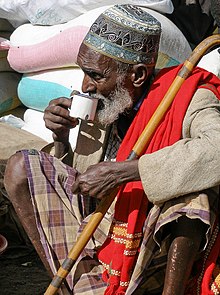Izaar

An izaar, also izar or ʾizār (Arabic: إِزَار),[1] also known as futah (فُوطَة),[2][3][4][5] maʿawaz (مَعَوَز),[6][7][8][9] wizarah (وِزَرَة),[10][11] maqtab (مَقْطَب)[12][13][14][15] is a traditional Yemeni clothing worn in Yemen especially by Hadhrami people who call it "saroun صارون" in their local dialect. It is a lower garment typically worn by men in Yemen, also known in United Arab Emirates, Iraq, Kuwait, Oman, Bahrain, Saudi Arabia and Qatar, and the Horn of Africa (Somalia, Somaliland, Djibouti, Ethiopia and Eritrea). Omani people typically wear a white izaar underneath the Thawb instead of sirwar pyjamas. Izaar-like clothing is also worn in countries such as Indonesia, Malaysia, Bangladesh, Pakistan and countries in some parts of East Africa and in India. It is commonly worn by Yemenis at home, and work.[16] In some parts of Arabia such as Yemen and the Jizan and ʿAsir regions of Saudi Arabia, it is known as futah instead. Some of these may feature tassels.
Similar garments[]
The izaar may be considered synonymous with the lungi in the Indian subcontinent and with the macawiis in the Horn of Africa. It may also be considered a type of sarong (spelt saroun صارون in Arabic).
It is similar to a kilt, except it is lighter and thinner. It is usually striped or patterned with bold colours (often with rectangular shapes), but it can also be found plain. An izaar is usually folded around the lower body, then wrapped tightly around the waist.
See also[]
References[]
- ^ http://journals.yu.edu.jo/jja/JJAIssues/Vol3No1_2010PDF/06.pdf
- ^ http://journals.yu.edu.jo/jja/JJAIssues/Vol3No1_2010PDF/06.pdf
- ^ http://nationalclothing.org/41-nationalclothing/middle-east/yemen/58-yemeni-traditional-dress-yemen-is-a-country-with-a-remarkably-diverse-fashion.html
- ^ "Fūṭah | clothing".
- ^ Marshall Cavendish (1 September 2006). World and Its Peoples. Marshall Cavendish. pp. 142–. ISBN 978-0-7614-7571-2.
- ^ http://www.26sep.net/newsweekarticle.php?sid=7030
- ^ http://journals.yu.edu.jo/jja/JJAIssues/Vol3No1_2010PDF/06.pdf
- ^ http://www.taizgov.com/new/component/content/article.html?id=216
- ^ "Archived copy". Archived from the original on 2016-10-07. Retrieved 2016-05-23.CS1 maint: archived copy as title (link)
- ^ "Exploring Saudi Arabia: Tihama and Faifa".
- ^ http://chrisspivey.org/the-sunday-spiv-010215/
- ^ http://www.26sep.net/newsweekarticle.php?sid=7030
- ^ Moshe Piamenta (1991). Dictionary of Post-Classical Yemeni Arabic Part: 2. BRILL. pp. 404–. ISBN 90-04-09293-5.
- ^ "Archived copy" (PDF). Archived from the original (PDF) on 2016-10-07. Retrieved 2016-05-23.CS1 maint: archived copy as title (link)
- ^ http://www.taizgov.com/new/component/content/article.html?id=216
- ^ ICharacter and Morals By Muhammad Saed Abdul-Rahman
- Arabic clothing
- History of Asian clothing